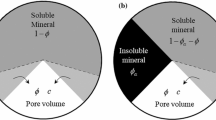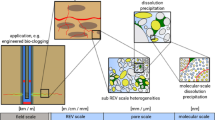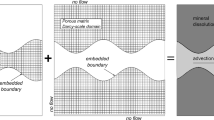Abstract
The relationship between flow properties and chemical reactions is the key to modeling subsurface reactive transport. This study develops closed-form equations to describe the effects of mineral precipitation and dissolution on multi-phase flow properties (capillary pressure and relative permeabilities) of porous media. The model accounts for the fact that precipitation/dissolution only takes place in the water-filled part of pore space. The capillary tube concept was used to connect pore-scale changes to macroscopic hydraulic properties. Precipitation/dissolution induces changes in the pore radii of water-filled pores and consequently in the pore size distribution. The updated pore size distribution is converted back to a new capillary pressure–water saturation relation from which the new relative permeabilities are calculated. Pore network modeling is conducted on a Berea sandstone to validate the new continuum-scale relations. The pore network modeling results are satisfactorily predicted by the new closed-form equations.












Similar content being viewed by others
Abbreviations
- \({\bar{S}}\) :
-
Effective water saturation
- \(\beta \) :
-
Ratio of pore volume after reactions to before reactions
- \(\phi \) :
-
Porosity after reactions
- \(\phi _0\) :
-
Initial porosity
- \(\tau \) :
-
Tortuosity
- h :
-
Capillary pressure head
- K :
-
Permeability after reactions
- \(K_0\) :
-
Initial permeability
- \(K_{\mathrm{g}0}\) :
-
Initial gas permeability
- \(k_{\mathrm{g}0}\) :
-
Initial gas relative permeability
- \(K_{\mathrm{g}}\) :
-
Gas permeability after reactions
- \(k_{\mathrm{g}}\) :
-
Gas relative permeability after reactions
- \(K_{\mathrm{w}0}\) :
-
Initial water permeability
- \(k_{\mathrm{w}0}\) :
-
Initial water relative permeability
- \(K_{\mathrm{w}}\) :
-
Water permeability after reactions
- \(k_{\mathrm{w}}\) :
-
Water relative permeability after reactions
- m :
-
Empirical parameter in the van Genuchten h–S relation
- r :
-
Radius of capillary tube
- \(r^*\) :
-
Radius after reactions
- \(r_\mathrm{p}\) :
-
Maximum radius up to which pores are water-filled
- S :
-
Water saturation
- \(S_\mathrm{p}\) :
-
Water saturation when mineral reaction occurs
- \(S_\mathrm{r}\) :
-
Residual water saturation
References
Algive, L., Békri, S., Nader, F.H., Lerat, O., Vizika, O.: Impact of diagenetic alterations on the petrophysical and multiphase flow properties of carbonate rocks using a reactive pore network modeling approach. Oil Gas Sci. Technol. 67(1), 147–160 (2012)
Bjørkum, P.A., Nadeau, P.H.: Temperature controlled porosity/permeability reduction, fluid migration, and petroleum exploration in sedimentary basins. APPEA J. 38(Part 1), 452–464 (1998)
Blunt, M.J.: Flow in porous media—pore-network models and multiphase flow. Curr. Opin. Colloid Interface Sci. 6(3), 197–207 (2001)
Blunt, M.J., Bijeljic, B., Dong, H., Gharbi, O., Iglauer, S., Mostaghimi, P., Paluszny, A., Pentland, C.: Pore-scale imaging and modelling. Adv. Water Resour. 51, 197–216 (2013)
Brace, W.: Permeability from resistivity and pore shape. J. Geophys. Res. 82(23), 3343–3349 (1977)
Carman, P.C.: Flow of Gases Through Porous Media. Academic Press, London (1956)
Ginn, T.R., Wood, B.D., Nelson, K.E., Scheibe, T.D., Murphy, E.M., Clement, T.P.: Processes in microbial transport in the natural subsurface. Adv. Water Resour. 25(8), 1017–1042 (2002)
Hiorth, A., Cathles, L., Madland, M.: The impact of pore water chemistry on carbonate surface charge and oil wettability. Transp. Porous Media 85(1), 1–21 (2010)
Kozeny, J.: Über kapillare Leitung des Wassers im Boden: (Aufstieg. Hölder-Pichler-Tempsky, Versickerung und Anwendung auf die Bewässerung) (1927)
Larson, R., Scriven, L., Davis, H.: Percolation theory of two phase flow in porous media. Chem. Eng. Sci. 36(1), 57–73 (1981)
Li, L., Peters, C.A., Celia, M.A.: Upscaling geochemical reaction rates using pore-scale network modeling. Adv. Water Resour. 29(9), 1351–1370 (2006)
Liu, H.-H., Zhang, G., Yi, Z., Wang, Y.: A permeability-change relationship in the dryout zone for \(\text{ CO }_2\) injection into saline aquifers. Int. J. Greenh. Gas Control 15, 42–47 (2013)
Mavis, F., Wilsey, E.: Filter sand permeability studies. Eng. News Rec. 118, 299–300 (1937)
Mualem, Y.: A new model for predicting the hydraulic conductivity of unsaturated porous media. Water Resour. Res. 12(3), 513–522 (1976)
Nogues, J.P., Fitts, J.P., Celia, M.A., Peters, C.A.: Permeability evolution due to dissolution and precipitation of carbonates using reactive transport modeling in pore networks. Water Resour. Res. 49(9), 6006–6021 (2013)
Ott, H., Roels, S., De Kloe, K.: Salt precipitation due to supercritical gas injection: I. Capillary-driven flow in unimodal sandstone. Int. J. Greenh. Gas Control 43, 247–255 (2015)
Panda, M.N., Lake, L.W.: A physical model of cementation and its effects on single-phase permeability. AAPG Bull. 79(3), 431–443 (1995)
Pruess, K., Müller, N.: Formation dry-out from CO\(_{2}\) injection into saline aquifers: 1. Effects of solids precipitation and their mitigation. Water Resour. Res. 45(3) (2009). doi:10.1029/2008WR007101
Raoof, A., Nick, H., Hassanizadeh, S., Spiers, C.: Poreflow: a complex pore-network model for simulation of reactive transport in variably saturated porous media. Comput. Geosci. 61, 160–174 (2013)
Ritter, H., Drake, L.: Pressure porosimeter and determination of complete macropore-size distributions. Pressure porosimeter and determination of complete macropore-size distributions. Ind. Eng. Chem. Anal. Ed. 17(12), 782–786 (1945)
Ryazanov, A., Van Dijke, M., Sorbie, K.: Two-phase pore-network modelling: existence of oil layers during water invasion. Transp. Porous Media 80(1), 79–99 (2009)
Schäfer, D., Schäfer, W., Kinzelbach, W.: Simulation of reactive processes related to biodegradation in aquifers: 1. Structure of the three-dimensional reactive transport model. J. Contam. Hydrol. 31(1), 167–186 (1998)
Schechter, R., Gidley, J.: The change in pore size distribution from surface reactions in porous media. AIChE J. 15(3), 339–350 (1969)
Steefel, C.I., DePaolo, D.J., Lichtner, P.C.: Reactive transport modeling: an essential tool and a new research approach for the earth sciences. Earth Planet. Sci. Lett. 240(3), 539–558 (2005)
Taylor, S.W., Jaffé, P.R.: Biofilm growth and the related changes in the physical properties of a porous medium: 1. Experimental investigation. Water Resour. Res. 26(9), 2153–2159 (1990)
Van Genuchten, M.T.: A closed-form equation for predicting the hydraulic conductivity of unsaturated soils. Soil Sci. Soc. Am. J. 44(5), 892–898 (1980)
Varloteaux, C., Békri, S., Adler, P.M.: Pore network modelling to determine the transport properties in presence of a reactive fluid: from pore to reservoir scale. Adv. Water Resour. 53, 87–100 (2013)
Verma, A., Pruess, K.: Thermohydrological conditions and silica redistribution near high-level nuclear wastes emplaced in saturated geological formations. J. Geophys. Res. Solid Earth (1978–2012) 93(B2), 1159–1173 (1988)
Xie, M., Mayer, K.U., Claret, F., Alt-Epping, P., Jacques, D., Steefel, C., Chiaberge, C., Simunek, J.: Implementation and evaluation of permeability–porosity and tortuosity–porosity relationships linked to mineral dissolution–precipitation. Comput. Geosci. 19(3), 655–671 (2015)
Zhang, S, Liu, H.-H.: Porosity-permeability relationships in modeling salt precipitation during CO\(_2\) sequestration: review of conceptual models and implementation in numerical simulations. Int. J. Greenh. Gas Control 52, 24–31 (2016)
Author information
Authors and Affiliations
Corresponding author
Rights and permissions
About this article
Cite this article
Zhang, S., Liu, HH., van Dijke, M.I.J. et al. Constitutive Relations for Reactive Transport Modeling: Effects of Chemical Reactions on Multi-phase Flow Properties. Transp Porous Med 114, 795–814 (2016). https://doi.org/10.1007/s11242-016-0744-5
Received:
Accepted:
Published:
Issue Date:
DOI: https://doi.org/10.1007/s11242-016-0744-5




